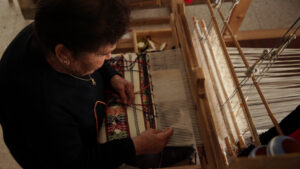Cyprus Mail 8 September 2022 - by Paul Lambis
In the village of Fyti, PAUL LAMBIS finds the mediaeval art of weaving is still going strong
From prehistoric villages to castles and forts, there is no shortage of ancient monuments and attractions on the island. However, Cyprus’ true charm lies in the countryside, where life revolves around shaded village squares – a central force of cultural life.
Overflowing with old-world romance and handsome medieval architecture, the village of Fyti, located on a hilltop in the Paphos region, is a model of unspoilt Cypriot authenticity and simplicity, providing an insight into the rustic character of Cyprus.
Picturesque and perfectly preserved, it is easy to fall for the quaint charms of Fyti. Though consisting of little more than a single cobbled street, this off-the-radar Paphos village is a showcase of period stone architecture and ancient monuments, with everything from art-filled Byzantine churches to the island’s largest evergreen tree.
“The village of Fyti is characterised by its distinct natural setting and time-honoured traditions, which welcome locals and visitors in an authentically warm and hospitable Cypriot spirit,” community leader Kyriacos Sotiriou said. “One of the things that draws individuals to the village is the tranquil harmony that such an atmosphere fosters between people and the natural world, which is noticeable as soon as they arrive.”
According to Sotiriou, the village of Fyti has been in existence since medieval times, and at the start of the 19th century was a spiritual and educational centre. “Children from the nearby villages travelled to Fyti to attend school, however the school was forced to close in the 1980s due to a lack of enrolment.”
Although the number of residents has decreased over the years, Sotiriou claims the population is growing as more expatriates choose a traditional home in a peaceful, rural village over the liveliness of the city. “Agrotourism has also played a significant part in bolstering the island’s rural tourism product, offering something different to the stereotypical holiday,” he added.
As the main weaving centre of the Paphos region, and one of the most significant in Cyprus, Fyti’s vibrant works of art have become a source of inspiration for many artists, fashion designers and authors who have enthusiastically encountered the village’s age-old heritage.
 Known as “fythkiotika,” this traditional craft is considered at risk or even “critically endangered,” according to Diamanto Diomidous, curator of the Fyti Weaving and Folk Art Museum.
Known as “fythkiotika,” this traditional craft is considered at risk or even “critically endangered,” according to Diamanto Diomidous, curator of the Fyti Weaving and Folk Art Museum.
“The art of weaving was well-known in Cyprus from antiquity; however, this great flourishment of Cypriot weaving was during the medieval period, especially during the era of the Luzonian kings,” Diomidous told Living. “Weaving was regarded as the most impressive form of domestic art and one of the greatest occupations for women,” she added.
 |
| Diamanto (right) and her mother Irene |
Diomidous learned the traditional art of weaving from her mother, Irene, who also acquired the skill from her own mother. In fact, she comes from a long line of weavers whose long-standing craft is practiced today. “While weaving represents an alternative source of income, it serves to maintain our family’s heritage and identity through an intricate array of art.”
Although many indigenous Cypriot crafts are in danger of becoming extinct, because of their time-consuming nature, and fewer craftspeople who possess these specialised skills, Diomidous has provided a platform through the Deputy Ministry of Tourism offering free mini apprenticeships to people interested in mastering the craft of weaving. “We have a significant number of participants who come from all over Cyprus because they are interested in learning, recognising the value of preserving our historical legacy, culture and knowledge.”
Built in 1947, the charming folk museum, which is located within the village square, houses a display of intricately decorated textiles, traditional clothing, farming instruments and donkey equipment. “The museum collection is a unique treasure of Fyti’s rural wealth, and offers an insight into traditional village life,” Sotiriou said.
In Fyti, life goes on as if in a different era. Whether a heritage tourist, travelling to experience the village or an adventurer that enjoys exploring the great outdoors on foot, Fyti caters for all.
If you are looking to get a healthy dose of fresh air and nature, Fyti’s best-kept-secret is literally on your doorstep. A short minute walk from the central square will lead you to a breath-taking location where an 800-year-old oak tree, arguably the largest on the island, stands tall, symbolising the strength, morale, resistance, and knowledge of the village and its people. All that is left to do is unwind, let go, and rediscover life’s simple treasures.

